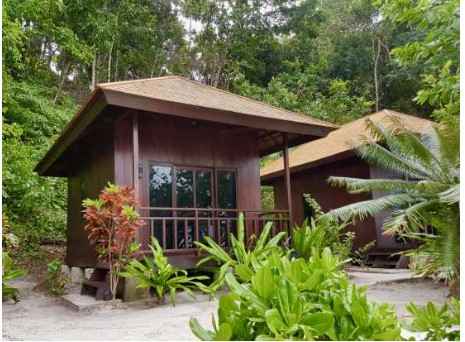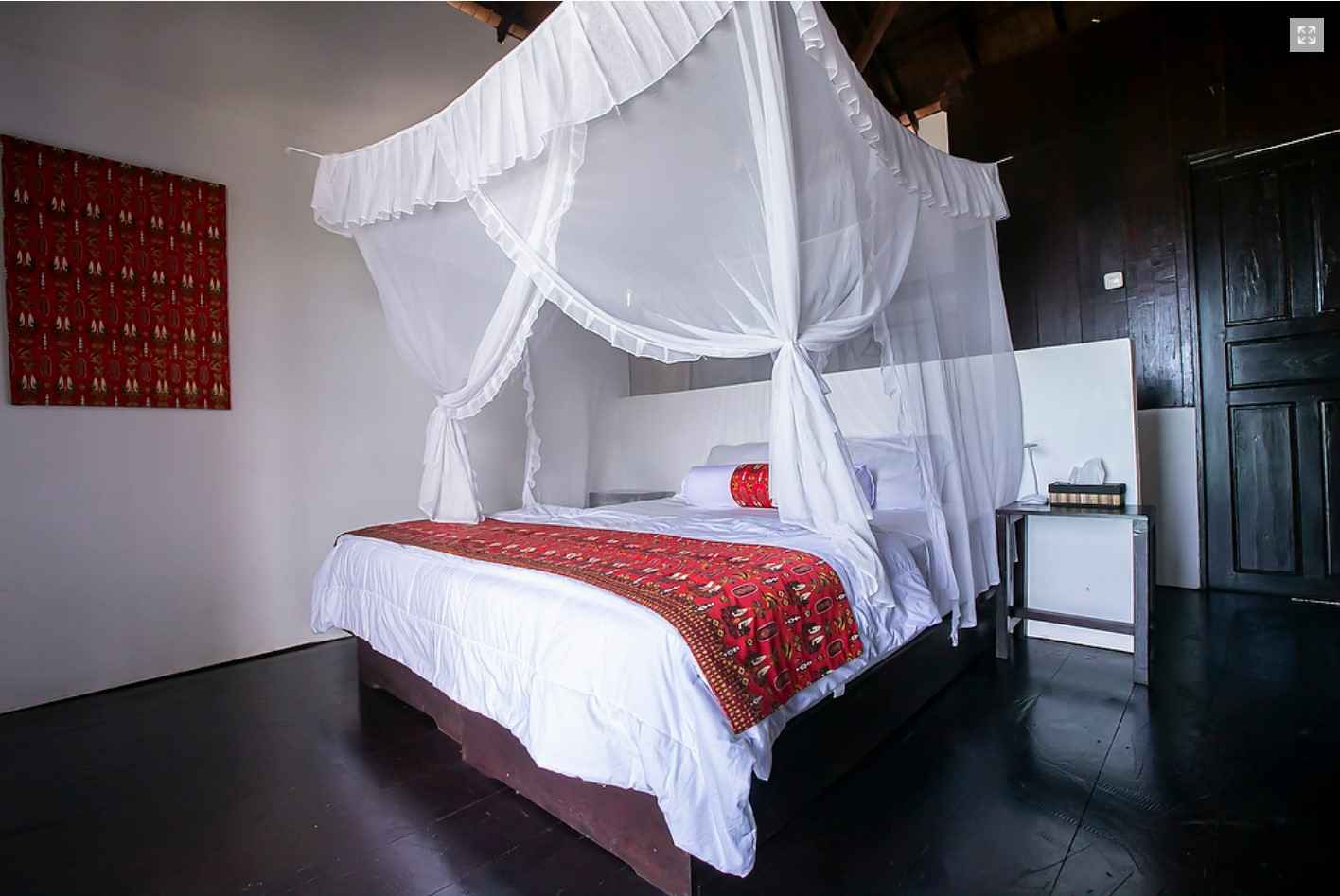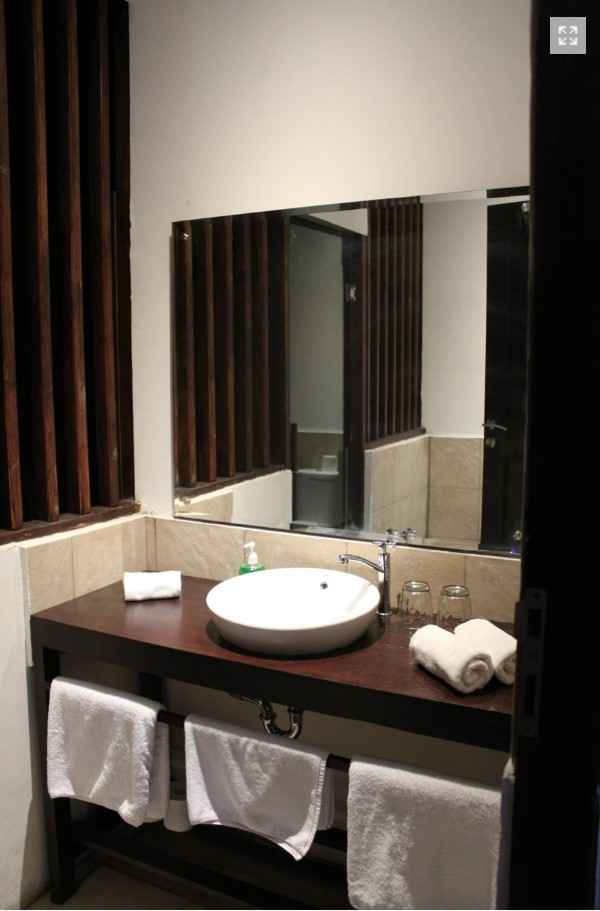Triton Bay Divers is the first and only dive resort located on a secluded beach on the island of Aiduma, just 90 minutes by speedboat from the town of Kaimana. It is a unique partnership between the resort’s founders and the local community which benefits from the project.
This is a divers paradise with more than 30 known dive sites around Triton Bay and many yet to be discovered. The resort is just minutes from some of the best dives sites in the area, where divers can see everything from whale sharks to pygmy seahorses. The region is also known for its beautiful soft coral and the spectacular P. Nursalim Flasher Wrasse, that is endemic to the area, and which Triton Bay Divers are happy to report can be found on their house reef.
Triton Bay is conscious of their environmental foot-print and have built the resort using sustainable natural local materials which blend in with the tropical surroundings. Any wood from trees that had to be removed has been utilized elsewhere throughout the resort using local craftsmen and traditional techniques whilst still allowing for a modern touch.
The resort’s 6 bungalows, all with sea views, are each able to sleep between 2 to 3 people comfortably. At the end of your day relax on your deck or enjoy a hot water shower in your private garden bathroom.
Each room is equipped with a large ceiling fan and designed with “natural” air conditioning in mind. There is a desk with extra (220v) power sockets, allowing you to download and view your photos whilst charging your camera in preparation for your next day of diving.
At this time, 24-hour electricity is not available, but there are plans to install solar panels in the not-to-distant future. Power will be on from 6:30 am to 11:00pm.



The Dive Center is located at the far end of the beach and inside you will find your own personal storage area where your dive equipment will be kept during your stay.
Three guided boat dives are offered per day, usually 2 in the morning and 1 in the afternoon, with the option of an additional sunset or night dive. Best of all, dives are not limited to the standard 60 mins, as sometimes that is just not long enough!
The Dive Team will take care of your equipment and clean it for you at the end of each day and before you leave the resort. There are also rinse tanks for your camera equipment as well as showers for you to rinse off between dives.
Triton Bay Divers also has PADI & SSI certified Instructors on hand in case you are looking to further your diving experience with a full range of courses from OWD to Dive Master. Non-divers are encouraged to take the plunge too.
Rental gear is available for hire, but there is limited stock so please let the resort know in advance your requirements so they can prepare everything for your arrival. 12- liter aluminum DIN tanks are used with INT adapters. At this time Nitrox is NOT available, so as always safe and sensible diving is recommended at all times.
Overview
In 2008 Kaimana Regency declared a 6000 sq km Marine Protected Area around the waters of Kaimana and Triton Bay. The marine biodiversity here is second to none and continues to surprise us with new finds every time we go diving. Dubbed by some as “the next frontier of Indonesian diving” and the “last best place”, Triton Bay offers something for everyone both above and below the waves. And best of all you will be one of only a few divers enjoying the waters in this very remote area.
We have over 30 dive sites already identified here and many more yet to explore. Dive sites range from pinnacles to shallow soft coral gardens, huge boulders draped in colorful corals, massive black coral bushes, drift and wall dives, as well as the opportunity for critter hunting. Triton Bay is becoming best known for its beautiful soft coral gardens and we have had guests suggest that this should be called the “soft coral capital of the world” with all due respect to Fiji.
Most of our dive sites are in and around the Iris Strait (the body of water between Aiduma Island and the mainland) just south east of Triton Bay. For the majority of our dives it is not necessary to venture deeper than 20m as the shallower parts boast the best coral and fish action. Unfortunately the price we pay for the speculator soft corals gardens and masses of schooling fish of every shape, color and size, is reduced visibility which varies considerably, but averages around 10 ~ 15 meters. Please note visibility can be as low as 5m or over 25m as it is dependent on weather and currents/upwelling. We try to plan our dives accordingly. Water temperatures vary between 28-30 degrees Celsius during the diving season and drop down to around 24 degrees during the eastern monsoon (June ~ Sept).
Almost all of the marine creatures found in other parts of Indonesia, too numerous to list, can be found here. The area offers everything from the tiniest pygmy seahorses to large and graceful whale sharks visiting the traditional fishing bagans. We have also seen pods of dolphins and marlin around these platforms. In addition, the region boasts a number of species found nowhere else, such as the elusive Triton Bay walking shark (Hemiscyllium henryi), and the beautiful P. Nursalim flasher wrasse, which outside of Triton Bay can only be found in Misool, south Raja Ampat.
SPECIAL NOTE REGARDING THE MARINE PARK FEE:
PLEASE NOTE THAT AS OF OCTOBER 2017, TRITON BAY DIVERS IS NO LONGER ISSUING GUESTS WITH MARINE PARK TAGS AS WE AWAIT CHANGES TO THE MARINE PARK TAG SYSTEM TO ENSURE ALL THE LOCAL VILLAGES RECEIVE FUNDS EXPECTED. HOWEVER, WE WILL CONTINUE TO ASK FOR RP 1,000,000 FROM EACH GUEST (EFFECTIVE SEPTEMBER 2022), AND WILL SET THE FUNDS ASIDE UNTIL SUCH TIME THAT A FORMAL MEETING BETWEEN THE TOURISM DEPT OF KAIMANA AND THE LOCAL VILLAGES CAN BE HELD AND A NEW SYSTEM CAN BE AGREED TO BY ALL. FOR TRANSPARENCY PURPOSES, A RECORD OF THE AMOUNTS COLLECTED FROM EACH GUEST ALONG WITH THE DATE OF STAY WILL BE KEPT AND CAN BE FOUND HERE FOR JUNE 2018 AND HERE FOR JUNE 2019.
Dive Sites
With 30 known dives sites around Triton Bay and possibly just as many yet to be discovered, below is a sneak peak at what you can expect to find here in Triton Bay. The better known of these sites were discovered by the Conservation International survey team in 2006, but there are a few that we like to think are known only to us! Indeed, the region is so rarely visited that we are still doing exploratory dives!
Saruenus Island
Locally nicknamed “Pintu Arus”/”Pulau Arus” (current island), this small island is just 5 minutes boat ride from our resort and offers diving experiences that will blow your mind! The most well known dive site is Little Komodo where the huge boulders nearly break the surface with soft corals and schools of anthias, damsel fish, and fusiliers. Deeper down, schools of sweetlips and snapper hang out in the black coral bushes, hunting jacks as well as wobbegong can also be found here. If you are in the mood for some macro photography, you can also find a number of different species of pygmy seahorses as well as nudis and shrimp. When the currents are playing nicely, you can gently drift along a beautiful soft coral covered wall and end your dive in Aquarium.
Aquarium is best dived in the morning when the waters are nice, calm and glassy on top to make the most of your reflection shots. Its a small dive site but boasts beautiful soft coral bommies and loads of schooling fish.
If you are looking for a little more action (conditions permitting) you can enjoy a drift dive along the western side at Pintu Arus! But beware currents can get crazy with eddies and timing on this dive site is everything! The soft coral gardens cover the wedding cake tiered reef like a carpet and is totally mind blowing! You can often be joined on the dive by giant grouper checking you out as well as schools of fusilier and anthias playing in the current! Note to self: if the fish can’t swim against the current you definitely can’t! But its fun to watch. Reef hooks might be a good option on this dive!
Bo’s Rainbow
Another dive site very close to our resort is Bo’s Rainbow , which has huge soft coral covered boulders with schools of fish. A relatively shallow dive, bottoming out into a gentle sandy slope at 16 meters it is perfect for both wide angle (especially when the sun is shinning) or macro. There is also a shallow swim through cutting through the middle of the island. If there is strong current, divers can stay within the protected side of the island. With no current you can easily swim around the entire island.
White Rock and Macro Rocks
White Rock can be dived day or night and should be named Candy Crab City!!! Covered with soft coral bushes it is a gentle sloping reef bottoming out at around 14 meters. This is mainly a macro site but we have also spotted wobbegong sharks and frogfish on this dive site. Macro Rock is mostly white sand bottom down to 20 meters, and is great for subjects like nudibranchs especially early in the season when the water temperature is cooler.
Andy’s Point
This dive site is always full of surprises! Every time we dive it we see something new from yellow fin barracuda, a squadron of Bumphead parrot fish, large schools of anchovies being hunted, devil rays cruising by, wobbegong sharks as well as solar powered nudis and pygmy seahorses. Most notable is that the black coral here may be more prodigious than anywhere else in Triton Bay! Visibility is not the best on this dive site but the rewards are numerous. Currents can be strong so stick with your dive guide.
Batu Jatuh
Batu Jatuh is Indonesian for “Fallen Rocks” and was so named for the massive boulders that rolled into the ocean not long ago. Since then the site seems to get better every year. This one has very large hard coral gardens which every photographer dreams of! It also hosts a large school of bat fish as well as hunting jacks, midnight snapper, bumphead parrot fish and napoleon wrasse. We have had surprise visits from mobula rays, eagle rays as well as the odd manta here so remember to look into the blue while you are diving!
Flasher Beach
Flasher Beach is located on an island outside of Triton Bay and north-west of Aiduma. It was named because of the beautiful Flasher Wrasse that are seen here. Flasher wrasse are the most colorful of all reef fish and are so named because of the mating displays by males during the late afternoon. This dive site is about 30 minutes ride from our resort and has at least three different species of flasher wrasse.
TBD House Reef
We are really excited to discover some great macro life on both of our house reef sites. Flasher Wrasse, Saron/Marble Shrimp, Harlequin shrimp as well as the LSD/Picturesque dragonet and mandarin fish! We have also spotted bob tail squid, starry octopus and walking sharks on our night dives!!!
Boulders
Just 15 minutes from the resort is a site with yet more large boulders covered with sea fans and soft corals…Beautiful for wide angle with schools of different species of glass fish and fusiliers, the rocks break the surface a low tide. It is also a great site for macro as a number of different species of pygmy seahorses can be found here as well as at the nearby sites of Bagus and Tangga.
Christmas Rock
Another signature dive site, Christmas Rock is a small island near the south of Aiduma. It is not a large dive site, but big bushes of black coral, wonderful soft coral covered bommies, and schools of snappers and surgeonfish can be found here. Better for wide angle photography but sharp eyed dive guides will be able to find some critters here.